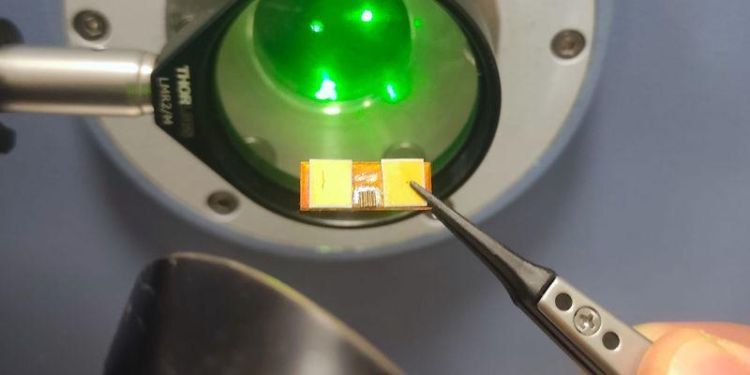New research brings incredible potential of ‘mode locking’ terahertz lasers a step closer

Scientists at the University of Leeds have collaborated with leading institutions across Europe to unlock the potential of under-exploited radiation in an untapped area of physics.
The findings of the project could open the door to a vast number of applications – from healthcare and imaging to climate science and space exploration.
Typically, lasers operate continuously and produce a steady beam of radiation, much like a laser pointer. To get pulses of radiation, they must be controlled – effectively switched on and off. However, regular pulses of radiation can have many applications, and this new research has shown a way of generating very rapid regular pulses of terahertz radiation automatically – known as mode locking – without the need for control via an external power supply and complex electronics.
Achieving mode locking in terahertz lasers has long been an ambition of those in the field, and now researchers from the University’s School of Electronic and Electrical Engineering – working closely with colleagues at prestigious institutions across Europe, including Italy’s CNR Istituto Nanoscienze and the Technical University of Munich – have achieved a landmark breakthrough.
This has been achieved in other parts of the electromagnetic spectrum, but never with terahertz.
The research team used an innovative device architecture that integrated localized strips of graphene distributed along a semiconductor quantum cascade terahertz laser. The resulting configuration proved to be compact, fully electronic, and extremely economical.

Team member Professor Giles Davies said: “Terahertz radiation is part of the electromagnetic spectrum – a type of radiation which has not really been exploited because it has been difficult to develop the technology that generates and detects it. [Most people] are familiar with other parts of the electromagnetic spectrum – visible light and X-rays and radio waves and microwaves – which are used in the everyday world in medical imaging and in mobile phones and so on.
“Terahertz is also part of the electromagnetic spectrum, but you may not have heard about it because it hasn’t been exploited; you can’t yet go into a shop and buy something that uses it. But we want to change that.”
Istituto Nanoscienze's Professor Miriam Serena Vitiello, lead author of the study, said: “Generating short pulses in the terahertz range through passive mode-locking was one of the longest standing goals over the last two decades, since it has long been assumed to be inherently hindered by the fast recovery times associated with the intersubband gain of such lasers. We innovatively combined the ground-breaking quantum cascade laser technology with graphene optical properties, to develop a new generation of passive mode-locked terahertz photonic wire lasers.”
Professor Edmund Linfield said: “Because the automatic pulses – which this research has achieved – have very precise timing, it opens us up to a whole new swathe of applications.
“With ‘active’ pulses [controlled by a battery or power source], there can be uncertainty in the exact pulse timing. The self-starting automatic pulses, which this research has achieved for the first time, have very precise timing, and that opens applications in physics, chemistry and spectroscopy.”
The team has already been working with the European Space Agency and UK Space Agency to put some of the newly developed technology into a satellite, where it could be used to look at gases in the upper atmosphere and potentially investigate the causes of climate change.
The University of Leeds’ group of researchers has long-standing international expertise in terahertz work; it is one of only a few groups internationally able to fabricate these specific lasers. That means scientists from all over the world often collaborate with the Leeds terahertz photonics group to work in this area of science and technology.
More discoveries could be on the horizon. Team member Dr Lianhe Li said: “This breakthrough also means the laser can be miniaturized, because you don’t need a whole big rack of electronics to control the pulse.
“Now that a self-pulsed laser in the terahertz frequency range has been achieved through our consortium between the University of Leeds and colleagues in Europe, this opens the way to a range of new applications around spectroscopy imaging.”
Further information
• “Short pulse generation from a graphene-coupled passively mode-locked terahertz laser” was published in Nature Photonics on Thursday, April 20. DOI 10.1038/s41566-023-01195-z.




